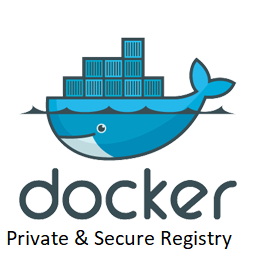Setting up private secure docker registry as service with authentication

Its extremely necessary to have a docker registry within your docker/kubernetes eco systems. Commonly we setup insecure docker registry by running registry image as docker container. BUT its recommended to have secure docker registry running as service(which gives you provision to have HA with multiple replica) for production grade environment. This blog will help you to setup secure docker registry running as service quickly.
Step- 1: Generate SSL certificate
Goal is to generate self signed ssl certificate and use it to secure docker registry. We would use openssl in order to generate ssl cert. Please skip this step if you have certificate from trusted authorities already.
#key openssl genrsa -out ca.key 2048
#cert openssl req -new -x509 -days 365 -key ca.key -subj '/C=US/ST=WA/L=Bellevue/O=xyzInc/OU=IoT/CN=10.0.1.3/' -out ca.crt
#server openssl req -newkey rsa:2048 -nodes -keyout server.key -subj '/C=US/ST=WA/L=Bellevue/O=xyzInc/OU=IoT/CN=10.0.1.3/' -out server.csr
#self sign openssl x509 -req -extfile <(printf 'subjectAltName=IP:10.0.1.3,IP:192.168.1.8, DNS:app.xyz.com') -days 365 -in server.csr -CA ca.crt -CAkey ca.key -CAcreateserial -out server.crt
#verify openssl x509 -in server.crt -text -noout
# please look for DNS entry/IP address.
Step 2: Create htpasswd entry for basic authentication
We will be using basic auth “htpasswd” utility to create a auth entry and use it to password protect the docker registry.
Please install if your environment missing the above htpasswd utility
#RHEL/CentOS based packages. Please modify the below according to your OS distribution sudo yum install httpd httpd-tools -y
Generate the auth entry
htpasswd -cB ~/.htpasswd cloud-user #enter password: Example - CC@123 #this will create a .htpasswd file in user's home dir
Add any additional user
htpasswd -cB ~/.htpasswd testuser #Please enter the password # Its also possible to provide password with the above command $htpasswd -cB ~/.htpasswd testuser password@321
Step 3: Prepare docker node(s) to host the docker registry
Copy the ssl certificate into below location and restart the docker service. This will help docker service to trust the self signed certificate otherwise you might get certificate error.
sudo mkdir -p /etc/docker/certs.d/10.0.1.3/ sudo cp server.crt /etc/docker/certs.d/10.0.1.3/ca.crt sudo systemctl restart docker
Start a docker swarm. Init manager and add as many nodes as you wish to have.
#Init.. Store the output to additional node joining sudo docker swarm init --advertise-addr 192.168.1.8 #List nodes sudo docker node ls #Label node(s) to host registry sudo docker node update --label-add registry=true <hostname>
Step 4: Create Registry docker service
We would create a docker service in this final part of the setup and test the registry.
Create docker secret for key as well as certificate
#sudo docker secret create <<target>> server.crt
#Cert sudo docker secret create domain.crt server.crt
#key sudo docker secret create domain.key server.key
# Please use the below if you wish to delete them #sudo docker secret rm domain.crt domain.key
Create the below dir to be mounted with the registry
sudo mkdir -p /var/lib/registry/ sudo mkdir -p /mnt/registry
Create the service
sudo docker service create \ --name cc-registry \ --secret domain.crt \ --secret domain.key \ --constraint 'node.labels.registry==true' \ --mount type=bind,src=/mnt/registry,dst=/var/lib/registry \ --mount type=bind,src=~/.htpasswd,dst=/cc-registry.htpasswd \ -e REGISTRY_HTTP_ADDR=0.0.0.0:443 \ -e REGISTRY_HTTP_TLS_CERTIFICATE=/run/secrets/domain.crt \ -e REGISTRY_HTTP_TLS_KEY=/run/secrets/domain.key \ -e REGISTRY_AUTH=htpasswd \ -e REGISTRY_AUTH_HTPASSWD_REALM='Registry Realm' \ -e REGISTRY_AUTH_HTPASSWD_PATH=/cc-registry.htpasswd \ --publish published=443,target=443 \ --replicas 1 \ registry:2
#Please use the below if you wish to delete them. Also adjust the name, replicas etc as per your need. #sudo docker service rm cc-registry
Docker login test
sudo docker login 10.0.1.3 --username cloud-user #Provide password #You should get a login succ msg otherwise please revisit the above steps.
Image push/pull test
sudo docker pull busybox sudo docker tag busybox 10.0.1.3/busybox sudo docker push 10.0.1.3/busybox sudo docker pull 10.0.1.3/busybox #You should able to perform the above operations otherwise please revisit the above steps.
Enjoy!!!!.